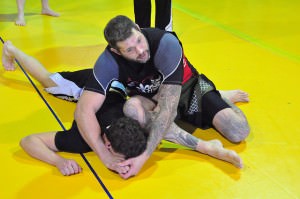History & Revival of Mixed Martial Arts (MMA) in Today’s Sporting World
Rewind: 1925 in Brazil
To bridge the gap between 648 BCE and today, we have to take another trip and take a look at what was happening in Brazil at the turn of the 20th century. More specifically, we’re honing in on Brazil’s legendary Gracie family, who can be accredited with MMA’s modern-day re-emergence.
Gastão Gracie, a political figure in Brazil at this time, met with Mitsuyo Maeda, a Japanese Martial Arts Champion. The two struck a deal of sorts, which included political support. Since Japan wanted to create a colony in Brazil, Maeda ended up teaching the oldest of Gastão Gracie’s sons, Carlos Gracie, the traditional martial art of jiu-jitsu.
Carlos in turn taught his three younger brothers (Helio, Jorge and Gastão Jr.) what he learned. When Mitsuyo Maeda eventually left the country, the four Gracie brothers decided to shirk the rigid rules of traditional Japanese martial arts and instead adapt the jiu-jitsu they learned to better fit their needs and increase its practicality. In 1925, Carlos and Helio opened a jiu-jitsu academy in Rio de Janeiro.
To increase interest and gain public attention, the two brothers issued what has come to be known as the Gracie Challenge. This was a simple ad in the local newspaper that included a picture of Carlos (who was the smaller of the two brothers), information about the academy, and a challenge that stated, “If you want a broken arm or rib, contact Carlos Gracie at this number.”
[pullquote]It’s estimated that Canada’s MMA fan base is some 6 million people (18%), and Canadian interest in the sport actually exceeds that of the US.[/pullquote]
The ad served its purpose. Martial arts enthusiasts and champions flocked to the Gracie jiu-jitsu academy to participate in the challenge. The sons of Carlos and Helio also began to participate in what became known as ‘vale tudo’ matches, which is Portuguese for ‘anything goes’ or ‘no rules.’ Popularity increased to the point where they began to be held in Brazilian soccer stadiums to appease all the spectators.
Modern day MMA in North America
What really brings us to modern day MMA fighting began in 1980 when Helio’s oldest son, Rorion, came to the United States to teach what is now known as Brazilian (or Gracie) Jiu-Jitsu in California. Once again, Rorion issued the Gracie Challenge, but brought it to another level by offering $100,000 to anyone who could defeat him or his brothers in a vale tudo match. These Gracie Challenge matches increased the popularity of Brazilian Jiu-Jitsu and fighting with, more or less, no rules.
Rorion eventually decided to create an organization that would bring this type of fighting all over the United States. To fulfill this desire, Rorion Gracie met with Art Davie (a salesman who became interested in MMA from underground fights he saw in Thailand), who managed to set up a meeting for the two of them with the president of Semaphore Entertainment Group (SEG), Bob Meyrowitz. SEG was a company that specialized in providing live, pay-per-view sporting events. In 1993, the Ultimate Fighting Championship was born.
































Share the post "History & Revival of Mixed Martial Arts (MMA) in Today’s Sporting World"